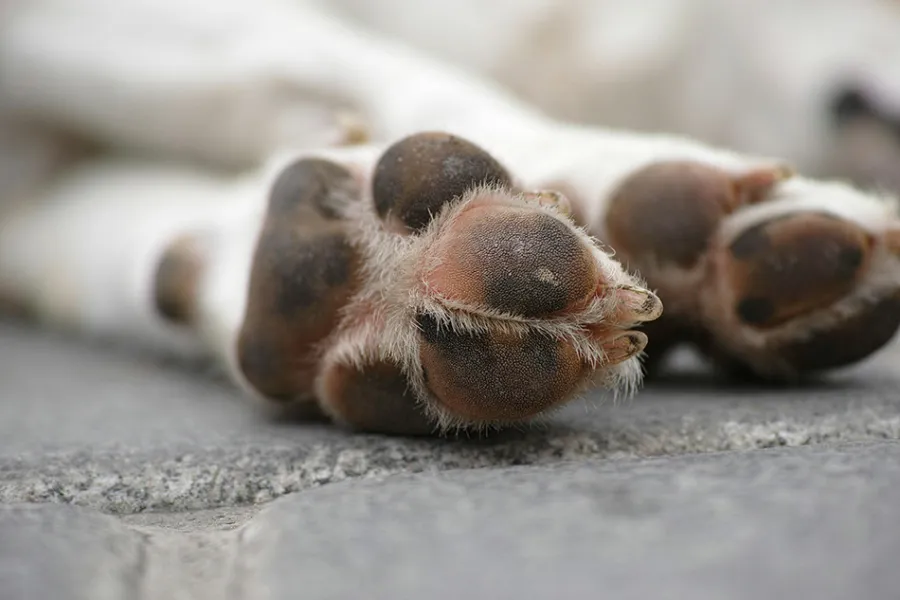PATHOLOGIES WE TREAT
Hyperkeratosis

Introduction
Hyperkeratosis is a dermatological condition that mainly affects dogs and, less frequently, cats. It is characterized by abnormal thickening of the skin, particularly on the nose, pressure points, and paw pads. This condition can cause discomfort and even pain if not properly managed. This article explains what hyperkeratosis is, its causes, symptoms, and how to treat it to ensure your pet’s well-being.
Causes
Hyperkeratosis is a skin disorder caused by excessive production of keratin, a protein that forms the outer layer of the skin. This leads to thickening and hardening of the skin in specific areas, such as the paw pads (plantar hyperkeratosis) or the nose (nasal hyperkeratosis), making them dry, rough, and sometimes painful for pets.
Identifying the underlying cause is crucial for proper treatment. The most common causes include:
- Genetics: Certain dog breeds, such as Labrador Retrievers, Bulldogs, and Cocker Spaniels, are more prone to developing hyperkeratosis due to hereditary factors.
- Aging: As pets age, they may experience skin changes, such as increased keratin thickness.
- Underlying diseases: Hyperkeratosis may be a symptom of other conditions, including:
- Leishmaniasis in dogs.
- Viral infections, such as canine distemper.
- Autoimmune diseases, such as lupus.
- Nutritional deficiencies: A lack of essential fatty acids or an inadequate diet may contribute to the development of hyperkeratosis.
Symptoms
The most common symptoms of hyperkeratosis include:
- Thickening and hardening of the skin on the nose, paw pads, or pressure points.
- Extreme dryness in affected areas.
- Cracks that may cause pain.
- Difficulty walking due to hardened paw pads.
- In severe cases, bleeding or secondary infections.
Diagnosis
A veterinarian diagnoses hyperkeratosis through a physical examination of the affected areas. If an underlying disease is suspected, additional tests such as bloodwork or skin biopsies may be performed to confirm the diagnosis.
Treatment
Hyperkeratosis can be effectively managed with appropriate treatment, improving your pet's quality of life and controlling symptoms.
- Topical treatment: Essential for softening and removing excess keratin in the affected skin. Products like Skinnia Repair, a bioadhesive gel with salicylic acid and urea, help exfoliate and soften hardened skin, promoting regeneration. Hydrating products, such as specialized balms for paw pads and noses, are also helpful in preventing cracks and improving skin flexibility.
- Treatment of underlying conditions: If hyperkeratosis is linked to an underlying disease, such as a viral or autoimmune condition, treating the primary disease is crucial. This may involve antiviral medications, antibiotics, or immunosuppressants.
- Supplementation: Adding essential fatty acids to the diet can improve skin hydration and help regulate keratin production.
Prevention
To prevent and manage hyperkeratosis in pets, follow these care tips:
- Regular application of hydrating and keratolytic products.
- Protect paw pads on rough or hot surfaces and avoid walks during peak heat.
- Maintain a balanced diet rich in essential fatty acids.
- Consult a veterinarian if your pet shows signs of hyperkeratosis to ensure early diagnosis.
Robinson, K. (2015). Disorders of the paw. In BSAVA Manual of Canine Practice (pp. 327-338). BSAVA Library.
Catarino, M., Combarros‐Garcia, D., Mimouni, P., Pressanti, C., & Cadiergues, M. C. (2018). Control of canine idiopathic nasal hyperkeratosis with a natural skin restorative balm: a randomized double‐blind placebo‐controlled study. Veterinary dermatology, 29(2), 134-e53.
Müller, G. H., Kirk, R. W., & Scott, D. W. (2012). Small Animal Dermatology (7th ed.). Saunders Elsevier.

Bioadhesive transparent gel with keratolytic effect indicated for smoothing and exfoliating the surface layer of the skin of pads and pressure points.